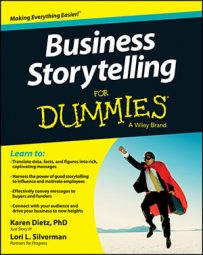The first step in measuring the results of a business story project is to lay out your objective and what you seek to accomplish. Do you want more loyal customers, more engaged employees, increased sales, improved leadership, better performing teams, and the like? The methods you use to collect or validate evidence also define your measures.
Collect evidence
Narrative analysis contains a set of methods for working with stories and measuring their return. If you’re serious about validating material and gaining deeper analysis of results, working with a PhD narrative researcher can help. Start by learning quantitative and qualitative methods related to storytelling.
Quantitative methods analytically treat stories as units of measure. The simplest quantitative approaches include counting the number of collected stories, creating a list of the collected story types or doing a pattern analysis of them, and generating statistics on these findings. Other quantitative tools include determining whether your story project generated results through website stats, social media analytics, numerical split test results, and so on.
Those trained in statistics can generalize a sample of stories into conclusions about an entire population. It sounds simple, but it’s hard work to isolate story from other variables to generate meaningful results.
Qualitative methods, rather than treat stories as units to statistically analyze, look for the construction of group identity or community. Here are five qualitative methods your organization can use to collect this evidence:
Collect anecdotal evidence.
Conduct thematic analyses of the collected stories.
Run a structural analysis of how collected stories are put together.
Analyze performance dynamics of stories being told and listened to.
Direct an analysis of how stories are conveyed visually.
Gain Return on Investment (ROI)
There are seven types of ROI from a storytelling project.
Validate that the message was heard
If you haven’t been heard, you have no chance of finding any other ROI because it doesn’t exist.
Capture changes in behavior
Researchers Arvind Singhal and Everett M. Rogers have proved that when subjects are exposed to believable experiences where behaviors are modeled via stories, their thoughts, emotions, and behaviors change. It’s up to you to determine which specific behaviors need to shift and how to measure this change over time.
Track engagement
Engagement is the degree to which you and your employees or customers, members, clients, or patients are talking together, sharing stories, acting on those stories, and receiving mutual benefit from the interaction.
Engagement can be measured through web-based analytics: retweets, blog comments, Pinterest re-pins, and the like. Qualitatively, you can measure it through the quality of the stories shared (such as when customers share stories with you in return) and the resulting interactions.
Even better is when customers become brand evangelists and create ads for your firm or even come work for your enterprise. Engagement is also evidenced when employees share stories to demonstrate a positive view of their work, entice colleagues to apply for jobs, and transfer knowledge to coworkers.
Document financial results
This category includes traditional ROI measures:
Measuring financial results stemming from an increase in sales.
Tracking the number of prospect appointments and closed sales, and the time it takes to turn a prospect into a customer.
Using measures in place through your firm’s performance management system to document gains in productivity.
Documenting product creation and licensing opportunities.
You can also document the statistical number of collected items available for use in marketing and branding purposes.
Measure emotions
Return on emotion is about you and your customers feeling emotionally connected to each other. Evangelists are people who are so emotionally attached or invested in your company and its products and services that they praise you everywhere they go. Measure return on emotion via social media stats, stories from sales representatives, interviewing longstanding customers, number of referrals received, and the like.
Loyalty is another term for this ROI. Return on emotion could be called return on meaning, because meaning is the end result of an emotional connection. People feel connected because they find something meaningful in the interaction. In some way you’ve emotionally connected with or satisfied a deep emotional need.
A return on meaning and emotion can be applied not only to external customers and clients, but internally to coworkers, staff, leaders, and anyone you want to influence.
Jonathan Harris takes comments people make on the web and creates emotional clouds about how they’re feeling. You can take the same approach to analyzing how emotionally connected people are to your organization’s brand, products, and services.
Track relationships
Here are three ways to think about return on relationships as an ROI:
In virtual workspaces where work teams are flung far and wide, you can measure storytelling’s impact on forming and cementing relationships and sustaining those relationships over time and distance.
In high-performing teams, you can track how stories are used to help transfer knowledge amongst team members and the speed at which they cycle through failures while achieving successes.
You can measure the life-cycle of your clients. The return on relationship is the difference between short-term transactions and longer-term relationships. Because it costs more to acquire new customers than to maintain current ones, you can document shifts in the quality and quantity of relationships and their length via a story initiative.
Innovate and be creative
Often stories help people expand their thinking, consider different options, and so on. For example, Gaylord Hospital’s conscious use of stories about innovative solutions and cost-cutting measures that staff came up with spurred other staff to think of innovations and created an organizational culture that pulled off a quick financial turnaround.
Apply story tools to daily work
Track how effective storytelling is in getting you work results. Are you accomplishing your work more quickly? Are you forging better relationships? Are you resolving conflicts more easily? You can also track the impact of storytelling using existing team measures. These include productivity, cost, quality, and satisfaction metrics. The challenge here was mentioned earlier: Teasing out the contribution of storytelling from other influences.

